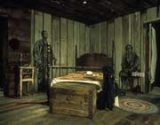Radcliffe Bailey’s exhibition “The Magic City” opened and closed at Blaffer Gallery on the same evening in June 2001, a victim of flooding brought about by Tropical Storm Allison. As torrents of rain closed roads and highways, causing bayous throughout the city to overflow, Bailey—unfamiliar with Houston—became stranded, and spent the night in his car before retuning to safety. All of Bailey’s paintings and installations are an intricate blend of personal experiences and historical references, and for “Tides” he has created a cycle of highly expressionistic visual tableaux that survey watery metaphors from a variety of perspectives.
Read More
